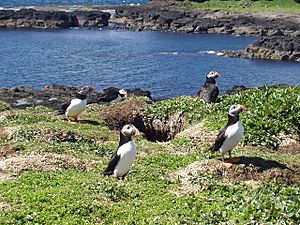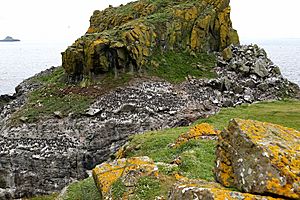Lunga, Treshnish Isles facts for kids
| Gaelic name | Lungaigh |
|---|---|
| Norse name | langr-øy |
| Meaning of name | "(long)ship island", from Norse |
| OS grid reference | NM278419 |
| Coordinates | 56°29′N 6°25′W / 56.49°N 6.42°W |
| Physical geography | |
| Island group | Treshnish Isles |
| Area | 81 ha (0.31 sq mi) |
| Area rank | 161 |
| Highest elevation | Cruachan, 103 m (338 ft) |
| Administration | |
| Sovereign state | United Kingdom |
| Country | Scotland |
| Council area | Argyll and Bute |
| Demographics | |
| Population | 0 |
The island of Lunga is the largest of the Treshnish Isles in Argyll and Bute, Scotland. The Isles are part of the Loch Na Keal National Scenic Area.
History
Lunga, which is of volcanic origin, has been described as 'a green jewel in a peacock sea'. It was inhabited until the 19th century, and still bears the remains of blackhouses. The remains of the ruined village, abandoned in 1857, lie in the northeastern part of the island.
Wildlife
As one of the Treshnish Isles, Lunga is a designated Site of Special Scientific Interest, Special Protection Area and Special Area of Conservation. These designations reflect the importance of the island for its marine life, including the grey seals that inhabit the waters around it, and for its breeding colonies of seabirds, including storm-petrels, kittiwakes, Manx shearwaters, guillemot, puffin, European shag and razorbills. (The birds also breed on the Harp Rock, a sea stack separated from Lunga by a narrow gut.) In addition, barnacle geese winter on the island.
Many rare and endangered plants are also native to Lunga, including primrose, birdsfoot trefoil, orchids, sea campion, sea thrift, sea pinks, yellow flags, tormentil and oyster plant.
In summer, tourist boats visit Lunga from Tiree, Tobermory, Iona and Ardnamurchan. The island’s thousands of breeding puffins, who allow visitors to approach to within a few feet of them, are the island’s main attraction.



